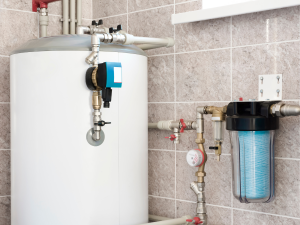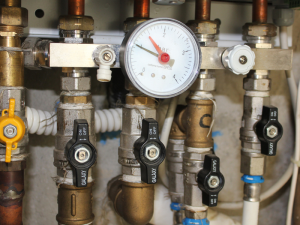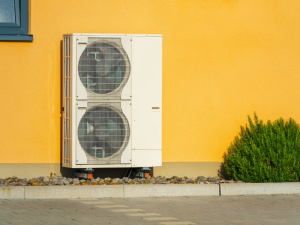Boilers are one of the many different kinds of heating systems available for home and business owners across Virginia.
Though more common in commercial buildings, like schools and malls, boilers are still a great option for homes, both big and small. However, these heating systems aren’t free from problems. This is why it can be incredibly useful for homeowners and business owners to learn how to bleed a boiler.
Bleeding your current boiler is a far simpler procedure that’s used to ensure that the system keeps working to its maximum efficiency.
While the process may sound far more complex at first, bleeding a boiler is simply letting air out of the pipes. However, this simple process can do quite a lot of good for the boiler and even increase its efficiency.
If you need to call a professional for help with your boiler or need to schedule a maintenance check, contact our team at Clover Contracting today!
The Impact of Air on a Boiler
Boilers are incredibly useful heating systems for commercial and residential spaces. Though they work similarly to furnaces, boilers replace oil or gas fuel for simple water.
The steam that’s created in a boiler is then spread through your home or office to heat the rooms. Bleeding a boiler is one of the key steps that many technicians do when servicing the system.
One key part that many people don’t realize, though, is that many boilers already do have a small amount of air inside them. Though it can get into the boiler’s pipes when it’s first installed, there’s not enough air inside it to actually do any damage to any parts. The constant expansion and contraction of the water in the boiler can also cause small bubbles to form.
The main issue, however, is when too much of that air forms inside the boiler. When extra air is created in the pipes, the need to start bleeding air from boiler units increases drastically. In most cases, the air is simply caused by those bubbles creating air pockets, which then displace the water inside. Naturally, the water displacement leads to the boiler itself losing its heating capabilities.
These air pockets, however, can also be caused by leaks and cracks in the boiler’s piping.
Signs That Your Boiler Needs the Air Bled Out
As with many of the different heating systems, a small amount of air inside the system can often be easy to notice. Whether it’s because of a sudden decrease in heating capacity or sudden noises coming from the system, the sudden changes can often be a sign. When it comes to a boiler, though, these signs are far less severe and more of a notice that it’s almost time for maintenance.
Odd Noises
Of course, since water is the main component and source of the heat, one of the signs that you need to learn how to bleed air from a boiler system is odd noises that you haven’t heard before. These sounds are the usual bubbling and gurgling as the air moves through the water and rattling as the radiator moves.
Uneven or Incorrect Heating
As mentioned before, one sign that you have air in the boiler’s system is a sudden decrease in heating. This can be the easiest sign to notice, especially in the winter, but you can also check the radiators themselves. Typically, the top will be colder due to the air pockets inside!
How to Bleed a Boiler System of Its Air
Many homeowners assume that bleeding their current boiler units is a complicated task.
Thankfully, the steps needed to learn how to bleed a boiler are quite simple. To bleed it on your own, you’ll need a few tools ready on top of a pair of heat-resistant gloves for added safety. Before you begin, get a towel, a bucket or tray to catch any drips, and a radiator bleed-key, though an appropriate screwdriver works too!
When you start, set the radiator to its maximum heat setting, making sure that the boiler starts sending its water through the pipes. Once the water reaches your radiator, leave the settings as is for at least fifteen minutes. Then turn off the boiler to start the cooling down process.
Once the water’s stopped moving through the system and the airflow has cut off, let the boiler and radiators cool for ten minutes. If it’s still warm, let it cool for another few minutes. If you have a radiator close to the boiler, set up your bucket or tray there to avoid needing to mop up the water. Then, use your screwdriver or bleed-key to open it up.
At first, the collected air that’s in the radiator will leak out as intended, so it’s important to keep the bleed valve open until you notice water. Close the valve and, if needed, empty the tray or bucket before moving on to the next radiator. Repeat the process for each radiator in your home, making sure to use safety tools as needed. Once every radiator’s been bled, turn your boiler on and check the water pressure.
Ideally, the water pressure should fall somewhere between one and a half to two bars. If that’s the reading you get, you’ve successfully bled your boiler. However, if it isn’t, you’ll need to call a technician or specialist for help. There’s a chance that, while the air was causing a few issues, the main problem is something that only a technician can find.
How To Bleed a Boiler in a Few Easy Steps — Takeaway
Though boilers are a somewhat odd system, they can also be quite eco friendly. As their name suggests, boilers boil water as a primary source of heating before pushing that hot water through the home and into each radiator. From there the water – or now steam – releases its heat before returning to the boiler. However, air can often become an issue.
Whether it finds its way into the boiler’s pipes during installation or operation, the air can start causing problems. This is where homeowners can learn how to bleed the boilers to do simple servicing at home. You can easily follow the steps mentioned above, but if you’d rather have a technician do it instead, just contact our team at Clover Contracting!




